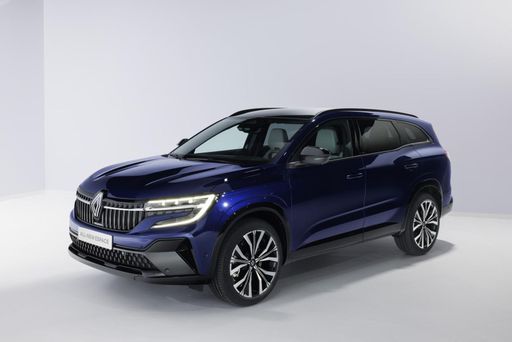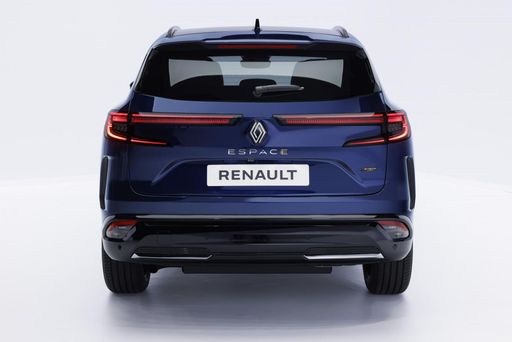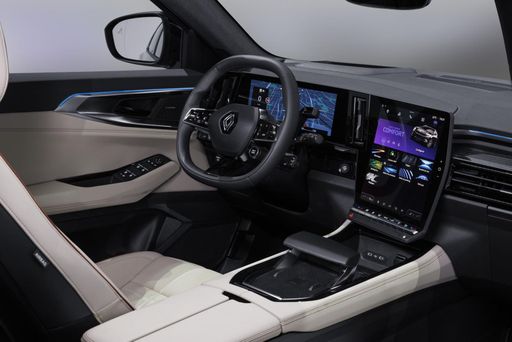Renault Trafic Bus vs Renault Espace – Performance, range & efficiency compared
Both models have their strengths – but which one suits you more?
Compare performance, efficiency, price and space directly: Renault Trafic Bus or Renault Espace?
Costs and Efficiency:
Looking at overall running costs, both models reveal some interesting differences in everyday economy.
Renault Espace has a barely noticeable advantage in terms of price – it starts at 37500 £, while the Renault Trafic Bus costs 38200 £. That’s a price difference of around 697 £.
Fuel consumption also shows a difference: Renault Espace manages with 4.90 L and is therefore noticeable more efficient than the Renault Trafic Bus with 6.70 L. The difference is about 1.80 L per 100 km.
Engine and Performance:
Under the bonnet, it becomes clear which model is tuned for sportiness and which one takes the lead when you hit the accelerator.
When it comes to engine power, the Renault Espace has a a bit edge – offering 200 HP compared to 170 HP. That’s roughly 30 HP more horsepower.
In acceleration from 0 to 100 km/h, the Renault Espace is distinct quicker – completing the sprint in 8.80 s, while the Renault Trafic Bus takes 10.60 s. That’s about 1.80 s faster.
In terms of top speed, the Renault Trafic Bus performs barely noticeable better – reaching 180 km/h, while the Renault Espace tops out at 174 km/h. The difference is around 6 km/h.
Space and Everyday Use:
Whether family car or daily driver – which one offers more room, flexibility and comfort?
Seats: Renault Trafic Bus offers noticeable more seating capacity – 9 vs 7.
In curb weight, Renault Espace is clearly perceptible lighter – 1673 kg compared to 2031 kg. The difference is around 358 kg.
In maximum load capacity, the Renault Trafic Bus performs convincingly better – up to 4000 L, which is about 1776 L more than the Renault Espace.
When it comes to payload, Renault Trafic Bus convincingly takes the win – 982 kg compared to 581 kg. That’s a difference of about 401 kg.
Who comes out on top?
Overall, the Renault Trafic Bus shows itself to be slightly ahead and secures the title of DriveDuel Champion.
It convinces with the more balanced overall package and proves to be the more versatile choice for everyday use.

Renault Trafic Bus
Renault Trafic Bus
The Renault Trafic Bus is a versatile and spacious option for those needing to transport multiple passengers comfortably. With its modern design and practical features, it is well-suited for both business and leisure purposes. Its efficient engine and smooth handling make it a reliable choice for long journeys.
detailsRenault Espace
The Renault Espace is a testament to innovative design, combining versatility with comfort to offer a unique driving experience. Its sleek exterior is complemented by a spacious interior, designed to cater to the needs of families and adventurers alike. With advanced technology and a focus on safety, the Espace seamlessly blends practicality with modern sophistication, making it a standout choice in the MPV segment.
details @ Renault
@ Renault
 @ Renault
@ Renault
 @ Renault
@ Renault
 @ Renault
@ Renault
 @ Renault
@ Renault
 @ Renault
@ Renault
|
|
|
|
|
Costs and Consumption |
|
|---|---|
|
Price
38200 - 54400 £
|
Price
37500 - 41400 £
|
|
Consumption L/100km
6.7 - 7.2 L
|
Consumption L/100km
4.90 L
|
|
Consumption kWh/100km
-
|
Consumption kWh/100km
-
|
|
Electric Range
-
|
Electric Range
-
|
|
Battery Capacity
-
|
Battery Capacity
-
|
|
co2
175 - 189 g/km
|
co2
110 g/km
|
|
Fuel tank capacity
80 L
|
Fuel tank capacity
55 L
|
Dimensions and Body |
|
|---|---|
|
Body Type
Bus
|
Body Type
SUV
|
|
Seats
8 - 9
|
Seats
5 - 7
|
|
Doors
4
|
Doors
5
|
|
Curb weight
2031 - 2352 kg
|
Curb weight
1673 - 1783 kg
|
|
Trunk capacity
-
|
Trunk capacity
212 - 692 L
|
|
Length
5080 - 5480 mm
|
Length
4746 mm
|
|
Width
1956 mm
|
Width
1830 mm
|
|
Height
1973 - 1974 mm
|
Height
1645 mm
|
|
Max trunk capacity
3200 - 4000 L
|
Max trunk capacity
2054 - 2224 L
|
|
Payload
718 - 982 kg
|
Payload
404 - 581 kg
|
Engine and Performance |
|
|---|---|
|
Engine Type
Diesel
|
Engine Type
Full Hybrid
|
|
Transmission
Manuel, Automatic
|
Transmission
Automatic
|
|
Transmission Detail
Manual Gearbox, Automatic Gearbox
|
Transmission Detail
Automatic Gearbox
|
|
Drive Type
Front-Wheel Drive
|
Drive Type
Front-Wheel Drive
|
|
Power HP
110 - 170 HP
|
Power HP
200 HP
|
|
Acceleration 0-100km/h
10.6 - 16.5 s
|
Acceleration 0-100km/h
8.80 s
|
|
Max Speed
161 - 180 km/h
|
Max Speed
174 km/h
|
|
Torque
300 - 380 Nm
|
Torque
-
|
|
Number of Cylinders
4
|
Number of Cylinders
3
|
|
Power kW
81 - 125 kW
|
Power kW
147 kW
|
|
Engine capacity
1997 cm3
|
Engine capacity
1199 cm3
|
General |
|
|---|---|
|
Model Year
2023 - 2025
|
Model Year
2025
|
|
CO2 Efficiency Class
G, F
|
CO2 Efficiency Class
C
|
|
Brand
Renault
|
Brand
Renault
|
What drive types are available for the Renault Trafic Bus?
The Renault Trafic Bus is offered with Front-Wheel Drive.
The prices and data displayed are estimates based on German list prices and may vary by country. This information is not legally binding.
